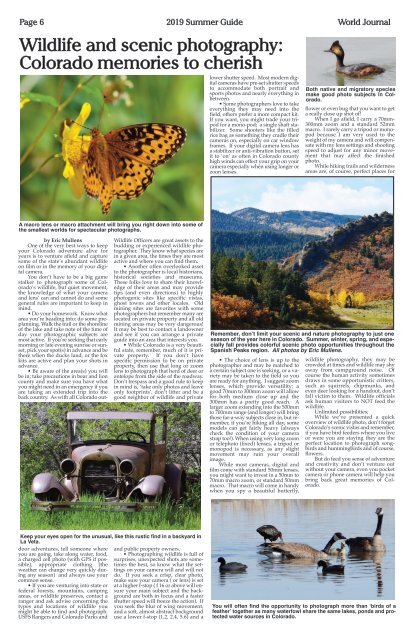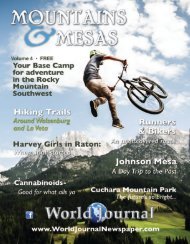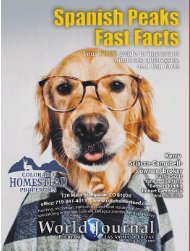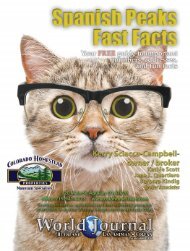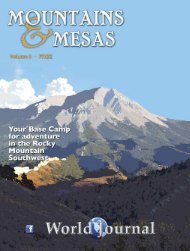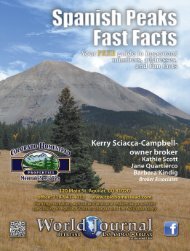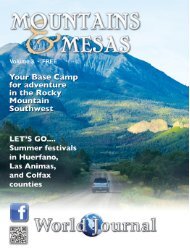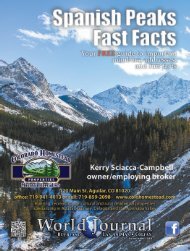2019 Summer Guide
Guide to businesses and activities year-round around the Scenic Highway of Legends in southern Colorado
Guide to businesses and activities year-round around the Scenic Highway of Legends in southern Colorado
You also want an ePaper? Increase the reach of your titles
YUMPU automatically turns print PDFs into web optimized ePapers that Google loves.
Page 6 <strong>2019</strong> <strong>Summer</strong> <strong>Guide</strong> World Journal<br />
Wildlife and scenic photography:<br />
Colorado memories to cherish<br />
lower shutter speed. Most modern digital<br />
cameras have pre-set shutter speeds<br />
to accommodate both portrait and<br />
sports photos and nearly everything in<br />
between.<br />
• Some photographers love to take<br />
everything they may need into the<br />
field, others prefer a more compact kit.<br />
If you want, you might trade your tripod<br />
for a mono-pod; a single shaft stabilizer.<br />
Some shooters like the filled<br />
rice bag as something they cradle their<br />
cameras on, especially on car window<br />
frames. If your digital camera lens has<br />
a stabilizer or anti-vibration button, set<br />
it to ‘on’ as often in Colorado county<br />
high winds can effect your grip on your<br />
camera especially when using longer or<br />
zoon lenses.<br />
Both native and migratory species<br />
make good photo subjects in Colorado.<br />
flower or even bug that you want to get<br />
a really close up shot of!<br />
When I go afield, I carry a 70mm-<br />
300mm zoom and a standard 52mm<br />
macro. I rarely carry a tripod or monopod<br />
because I am very used to the<br />
weight of my camera and will compensate<br />
with my lens settings and shooting<br />
speed to adjust for any minor movement<br />
that may affect the finished<br />
photo.<br />
While hiking trails and wilderness<br />
areas are, of course, perfect places for<br />
A macro lens or macro attachment will bring you right down into some of<br />
the smallest worlds for spectacular photographs.<br />
Wildlife Officers are great assets to the<br />
budding or experienced wildlife photographer.<br />
They know what species are<br />
in a given area, the times they are most<br />
active and where you can find them.<br />
• Another often overlooked asset<br />
to the photographer is local historians,<br />
historical societies and museums.<br />
These folks love to share their knowledge<br />
of their areas and may provide<br />
tips (and even directions) to highly<br />
photogenic sites like specific vistas,<br />
ghost towns and other locales. Old<br />
mining sites are favorites with some<br />
photographers but remember many are<br />
located on private property and all old<br />
mining areas may be very dangerous!<br />
It may be best to contact a landowner<br />
and see if you can arrange a private<br />
guide into an area that interests you.<br />
• While Colorado is a very beautiful<br />
state, remember, much of it is private<br />
property. If you don’t have<br />
specific permission to be on private<br />
property, then use that long or zoom<br />
lens to photograph that herd of deer or<br />
antelope from the side of the roadway.<br />
Don’t trespass and a good rule to keep<br />
in mind is, ‘take only photos and leave<br />
only footprints’, don’t litter and be a<br />
good neighbor of wildlife and private<br />
Remember, don’t limit your scenic and nature photography to just one<br />
season of the year here in Colorado. <strong>Summer</strong>, winter, spring, and especially<br />
fall provides colorful scenic photo opportunities throughout the<br />
Spanish Peaks region. All photos by Eric Mullens.<br />
• The choice of lens is up to the<br />
photographer and may be matched to<br />
a certain subject one is seeking, or a variety<br />
may be taken to the field so you<br />
are ready for anything. I suggest zoom<br />
lenses, which provide versatility; a<br />
good 70mm to 300mm zoom will allow<br />
for both medium close up and the<br />
300mm has a pretty good reach. A<br />
larger zoom extending into the 500mm<br />
to 700mm range (and longer) will bring<br />
those far-a-way subjects close in, but remember,<br />
if you’re hiking all day, some<br />
models can get fairly heavy (always<br />
check the condition of your camera<br />
strap too!). When using very long zoom<br />
or telephoto (fixed) lenses, a tripod or<br />
monopod is necessary, as any slight<br />
movement may ruin your overall<br />
image.<br />
While most cameras, digital and<br />
film come with standard 50mm lenses,<br />
you might want to invest in a 50mm to<br />
70mm macro zoom, or standard 50mm<br />
macro. That macro will come in handy<br />
when you spy a beautiful butterfly,<br />
wildlife photography, they may be<br />
crowded at times and wildlife may shy<br />
away from campground noise. Of<br />
course the human activity sometimes<br />
draws in some opportunistic critters,<br />
such as squirrels, chipmunks, and<br />
even deer looking for a handout, don’t<br />
fall victim to them. Wildlife officials<br />
ask human visitors to NOT feed the<br />
wildlife.<br />
Unlimited possibilities;<br />
While we’ve presented a quick<br />
overview of wildlife photo, don’t forget<br />
Colorado’s scenic vistas and remember,<br />
if you have bird feeders where you live<br />
or were you are staying they are the<br />
perfect location to photograph songbirds<br />
and hummingbirds and of course,<br />
flowers.<br />
But do feed you sense of adventure<br />
and creativity and don’t venture out<br />
without your camera, even you pocket<br />
camera or phone camera will help you<br />
bring back great memories of Colorado.<br />
Keep your eyes open for the unusual, like this rustic find in a backyard in<br />
by eric mullens<br />
One of the very best ways to keep<br />
your Colorado adventure alive for<br />
years is to venture afield and capture<br />
some of the state’s abundant wildlife<br />
on film or in the memory of your digital<br />
camera.<br />
You don’t have to be a big game<br />
stalker to photograph some of Colorado’s<br />
wildlife, but quiet movement,<br />
the knowledge of what your camera<br />
and lens’ can and cannot do and some<br />
general rules are important to keep in<br />
mind.<br />
• Do your homework. Know what<br />
area you’re heading into; do some preplanning.<br />
Walk the trail or the shoreline<br />
of the lake and take note of the time of<br />
day your photographic subjects are<br />
most active. If you’re seeking that early<br />
morning or late evening sunrise or sunset,<br />
pick your spot(s) in advance and be<br />
there when the ducks land, or the fox<br />
kits are active and plan your shots in<br />
advance.<br />
• Be aware of the area(s) you will<br />
be in; take precautions in bear and lion<br />
county and make sure you have what<br />
you might need in an emergency if you<br />
are taking an extended trip into the<br />
back country. As with all Colorado out-<br />
La Veta.<br />
door adventures, tell someone where<br />
you are going, take along water, food,<br />
a charged cell photo (with GPS if possible),<br />
appropriate clothing (the<br />
weather can change very quickly during<br />
any season) and always use your<br />
common sense.<br />
• If you are venturing into state or<br />
federal forests, mountains, camping<br />
areas, or wildlife preserves, contact a<br />
ranger and ask advise concerning the<br />
types and locations of wildlife you<br />
might be able to find and photograph.<br />
USFS Rangers and Colorado Parks and<br />
and public property owners.<br />
• Photographing wildlife is full of<br />
surprises, unexpected shots are sometimes<br />
the best, so know what the settings<br />
on your camera will and will not<br />
do. If you seek a crisp, clear photo,<br />
make sure your camera ( or lens) is set<br />
at a higher f-stop ( f 16 or above will ensure<br />
your main subject and the background<br />
are both in focus and a faster<br />
shutter speed will freeze the action). If<br />
you seek the blur of wing movement,<br />
and a soft, almost abstract background<br />
use a lower f-stop (1.2, 2.4, 5.6) and a<br />
You will often find the opportunity to photograph more than ‘birds of a<br />
feather’ together as many waterfowl share the same lakes, ponds and protected<br />
water sources in Colorado.


